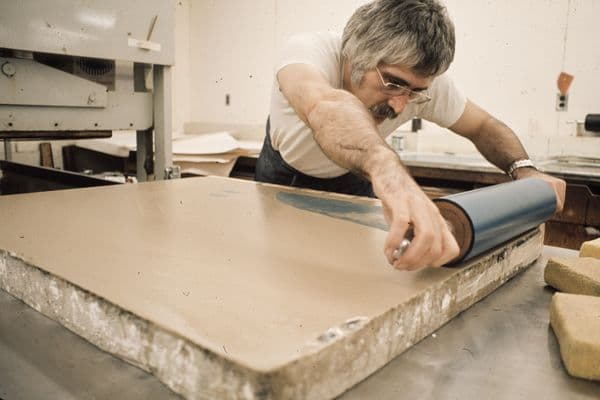Design and Construction

The National Gallery of Australia near completion, c. late 1980.

Artist's impression of the Gallery's main entrance from the pedestrian concourse, Australian National Gallery, Canberra: NCDC, 1974
The opening of the National Gallery in 1982 concluded a planning, design and construction period of fourteen years. In 1968 the government announced a limited competition to establish an approach to the design of a national gallery in Canberra, inviting thirteen Australian architectural firms to submit proposals for a building to be completed in the early 1970s. The then Prime Minister, John Gorton, remarked:
It is very important that the design of the gallery should reflect the most modern thinking of the present day, that it should be particular to Australia, and be an expression of the national character.
The Sydney firm Edwards Madigan Torzillo and Partners won the competition, with a design by the senior partner of the firm, Colin Madigan, leading the team of Christopher Kringas, Renato Giacco and Michael Rolfe. Announcing the winner in July 1968, the Prime Minister stated:
The competition had as its aim not a final design for the building but rather the selection of a vigorous and imaginative architect who would then be commissioned to submit the actual design of the Gallery. I believe that the competition has achieved that aim. Although a site for the Gallery is not yet finally determined, the selection of the architect allows the planning for the National Gallery to proceed to the next stage.
The design concept had been developed for a national gallery on Capital Hill, not beside Lake Burley Griffin. A proposal for a National Centre, promulgated in 1963 by the authority for Canberra, the National Capital Development Commission (NCDC), had suggested a Capital Hill location for the gallery with other national institutions, and a central lakeside site for the new Parliament House.1
The National Gallery’s ultimate lakeside position was not decided until May 1970 after lengthy debate concerning the siting of Parliament House – which was finally located at the summit of Capital Hill. At its lakeside site, the Gallery forms part of the Parliamentary Triangle, with Parliament House symbolically at the apex, the National Library of Australia within the north-west angle and the High Court of Australia and the National Gallery of Australia within the north-east angle at the base of the triangle.
A design brief for the National Gallery at this new location was given to the architects who developed the detailed building program during the latter part of 1970 and early 1971, with extensive input from consultant JJ Sweeney and the Gallery’s founding Director, James Mollison.2 Sketch plans were approved in April 1971 by the Gallery’s Interim Council, the NCDC and the government. On 7 November 1973, a plaque marking the start of construction was unveiled by Prime Minister Gough Whitlam,3 with the expectation that the Gallery would be completed by 1976.4
The adjacent High Court of Australia had also been designed by Edwards, Madigan, Torzillo and Partners. Both buildings form a powerful grouping of sculptural, yet functional elements that visually balance the composition of other major structures within the Parliamentary Triangle. They were to form an integral part of a proposed National Place linking them to the National Library via elevated pedestrian walkways and a vast public square.5
The only completed part of this plan is the pedestrian overpass between the National Gallery and High Court buildings. The area is now the site of Commonwealth Place and Reconciliation Place, opened in July 2002.
A combination of diminished capital project funding and a government priority for the completion of the High Court by 1980 meant that construction of the Gallery was temporarily halted in 1975 and would not be completed until October 1981 . The building, which was opened by Her Majesty Queen Elizabeth II on 12 October 1982, won the Royal Australian Institute of Architects (ACT) Canberra Medallion in 1982 and is listed on Australia’s Register of the National Estate.
The National Gallery of Australia is the most substantial and complex of Madigan’s buildings, a powerful structure reflecting his beliefs in organic evolution, the expression of materials, environmental integration and functional design that grows from human needs.
Robert Bell
Senior Curator, Decorative Arts and Design
Notes
1. The National Centre design was prepared for the NCDC by William Holford & Partners of London. See Roger Johnson, ‘The siting and design of the building’, in James Mollison and Laura Murray (eds), Australia National Gallery: an Introduction, Canberra: Australian National Gallery, 1982, pp.19–28.
2. JJ Sweeney, consultant to the NCDC on the Gallery project, was formerly the second Director of the Solomon R Guggenheim Museum, New York and Director of the Museum of Fine Arts, Houston, Texas; he made several influential visits to Canberra. James Mollison was appointed Acting Director of the Gallery in 1971 and Director in 1977.
3. The plaque is located at ground level, under the walkway between the National Gallery and High Court buildings.
4. The builder was PDC Constructions (ACT), a subsidiary of White Industries Ltd, under the supervision of the NCDC.
5. The 400 square metre National Place, proposed in 1971 by Roger Johnson, chief architect of the NCDC, was abandoned in 1975.











